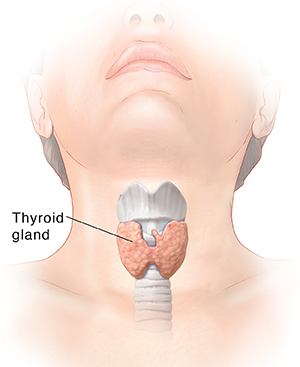Thyroid Cancer: Introduction
What is cancer?
Cancer starts when cells in the body change (mutate) and grow out of control. To help you understand what happens when you have cancer, let's look at how your body works normally. Your body is made up of tiny building blocks called cells. Normal cells grow when your body needs them, and die when your body doesn't need them any longer.
Cancer is made up of abnormal cells that grow even though your body doesn't need them. In most cancers, the abnormal cells grow to form a lump or mass called a tumor. If cancer cells are in the body long enough, they can grow into (invade) nearby tissues. They can even spread to other parts of the body (metastasize).
What is the thyroid gland?
The thyroid gland is part of the endocrine system. It makes and helps control hormones and the metabolism in your body. It's in the front of your neck, over your windpipe (trachea). It's below your Adam’s apple (thyroid cartilage) and above your collarbone. You often can’t see or feel your thyroid.
It’s shaped like a butterfly with 2 lobes—a right and left lobe. The lobes are joined by a bridge of tissue called the isthmus.

The thyroid is made up of 2 main types of cells:
-
Follicular cells. These use iodine to make thyroid hormones. These hormones help control your metabolism.
-
C cells or parafollicular cells. These make the hormone calcitonin. This helps control calcium levels.
What is thyroid cancer?
Thyroid cancer starts in the cells that make up the thyroid gland.
There are 5 main types of thyroid cancer (or carcinoma):
-
Papillary cancer. This is the most common type. It starts in the follicular cells. It tends to form in only 1 side of the thyroid gland and grow slowly. This type of thyroid cancer may spread to lymph nodes in the neck.
-
Follicular cancer. This cancer also forms in the follicular cells of thyroid cancer. It's the next most common type and accounts for about 1 in 10 cases. It's more common in countries where people don't get enough iodine in their diet. This type of thyroid cancer may spread to other areas of the body. It doesn't spread to the lymph nodes very often.
-
Hurthle cell cancer. This is a rare form of follicular thyroid cancer. It's harder to find and treat. It tends to not cause symptoms and has often spread to nearby lymph nodes by the time it's found.
-
Medullary thyroid cancer (MTC). This is a rare type of thyroid cancer that starts in the C cells. It is also considered a neuroendocrine tumor. It produces a lot of calcitonin and tends to spread very fast.
-
Anaplastic cancer. This is also called undifferentiated thyroid cancer. It's very rare. It tends to grow and spread quickly. It's hard to treat.
Most thyroid changes are not cancer
Changes in the thyroid gland are often easy to see and feel. Lumps or bumps, called nodules, are common. Most of them are not cancer (95% to 96% are benign). And they may not need to be treated. Growths that are not cancer don’t spread from the thyroid to other parts of your body.
Thyroid adenomas are small nodules that start in the thyroid gland. They're not cancer. Many times, they're only found while looking at the area around the thyroid for another reason.
Some thyroid adenomas make thyroid hormone. If an adenoma makes too much thyroid hormone, it can cause hyperthyroidism (toxic nodule). This is when there's too much thyroid hormone in your body. It can cause severe tiredness (fatigue), sweating, tremors, and heart palpitations. It may need to be treated.
Some signs that a nodule may be cancer and not an adenoma or other benign nodule include:
-
The nodule is not making hormones.
-
The nodule is solid instead of filled with fluid, like a cyst.
-
The nodule is growing fast.
-
Lymph nodes around the thyroid gland are swollen.
How thyroid cancer spreads
When thyroid cancer spreads outside the thyroid gland, it most often goes to nearby lymph nodes first. It can also spread to nearby blood vessels and other tissues in the neck. Over time, it can spread to distant parts of the body, such as the lungs and bones.
Talk with your healthcare provider
If you have questions about thyroid cancer, talk with your healthcare provider. Your healthcare provider can help you understand more about this cancer.